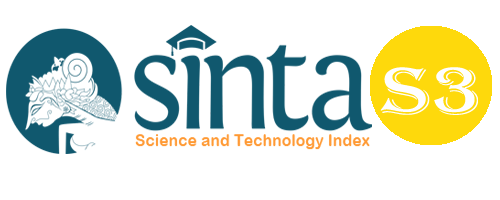Analysis of Slang Words Used in Movie Script “Lady Bird”: Sociolinguistics Study
Abstract
The research entitled “Analysis of Slang Words Used in the Script of the Film “Lady Bird”: Sociolinguistic Study is concerned with the use of language in everyday life, which closely provides additional information used in the film. The purpose of this study is analyzed and examine closely the type of slang words that occur in the movie Lady Bird and the reasons behind of it. The method used in carrying out the study was a descriptive analysis method. The data used were taken from the Greta Gerwig’s movie script classify the data into their types used theory from Chapman (1988) and the reasons of the character using the slang were analysed by using theory from Allan & Burridge (2006). The results demonstrated that there are two types of slang words, namely primary slang (84%) and secondary slang (16%). Besides, there are seven reasons, namely To Address, To Form Intimate Atmosphere, To Initiate Relax Conversation, To Show Impression, To Show Intimacy, To Reveal Anger, and To Humiliate. In fact, the analysis reveal primary slang is the most used slang that emerges frequently in Lady Bird context due to the expression which commonly used in daily conversation.
Keywords
Full Text:
PDFReferences
Alan C. L. Yu (2004) Reduplication in English Homeric Infixation.
Allan, Keith & Burridge, Kate. 2006. Forbidden Words: Taboo and the Censoring of Language. United Kingdom: Cambridge University Press.
Bayyurt, Y. (2013). Current perspectives on sociolinguistics and English language education. The Journal of Language Teaching and Learning, 1, 69–78. http://www.jltl.org/jltl/
Chapman, Robert L. 1998. A New Dictionary of American Slang. London: Harper & Row Publisher Inc.
Clissett, P. (2008) "Evaluating Qualitative Research." Journal of Orthopaedic Nursing 12: 99-105
Cong, D., & Silitonga, F. (2015). The Slang in Gay Best Friend Movie, 99–110
Dooly, Melinda. 2006. Semantics and Pragmatics of English: Teaching English
Fromkin, V., & R. Rodman. 2003. An Introduction to Language: Cengage Learning.
Holmes, Janet. (2001). An Introduction to Sociolinguistics.London: Longman Partridge, Eric. (2004). Slang: Today and Yesterday. London: Routledge and Kegan Paul Ltd
Holmes.j,1992. An introduction to sociolinguistics. London: Longman press Keraf, Gorys. 1994.
Love, S., Ho, N. O., & Langga, S. L. (1988). The meaning analysis of slang used in notorious b.i.g’s song. Ojs.Unud.Ac.Id. https://ojs.unud.ac.id/index.php/sastra/article/download/4430/3345
Purba, N. et al. (2020). Language Acquisition of Children Age 4-5 Years Old in TK Dhinukum Zholtan Deli Serdang. Linglit Journal: Scientific Journal of Linguistics and Literature. P.19-24
Simatupang, E. C. M., & Amalia, S. (2019). A Sociolinguistic Study of Code Switching Among Overseas Indonesian Students on Facebook Comments. International Journal of Innovation, Creativity and Change. Www.Ijicc.Net, 7(9). www.ijicc.net
Rachmijati, C., & Siliwangi -Bandung, S. (n.d.). An Analysis Of The Slang Language Used In The Movie “Juno.” http://www.wisegeek.com/what-is-slang.htm
Spolsky, Bernard. (1998). Sociolinguistics. New York: Oxford University Press.
Strauss, A., & Corbin, J. M. (1990). Basics of qualitative research: Grounded theory procedures and techniques. Sage Publications, Inc.
Wardaugh, Ronald. (2008). An Introduction to Sociolinguistics. USA: Blackwell
Yule, George. 2010. The Study of Language. Cambridge: Cambridge University Press.
DOI: https://doi.org/10.33258/birci.v5i3.5832
Article Metrics
Abstract view : 319 timesPDF - 96 times
Refbacks
- There are currently no refbacks.

This work is licensed under a Creative Commons Attribution-ShareAlike 4.0 International License.

This work is licensed under a Creative Commons Attribution-ShareAlike 4.0 International License.

_.gif)

















_.gif)



